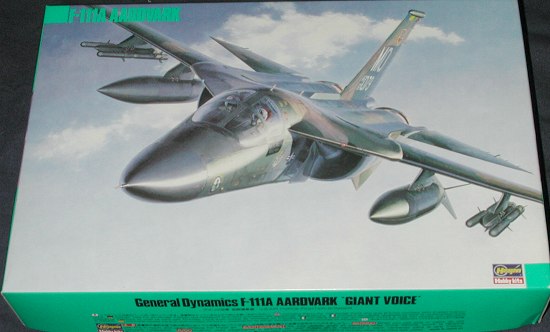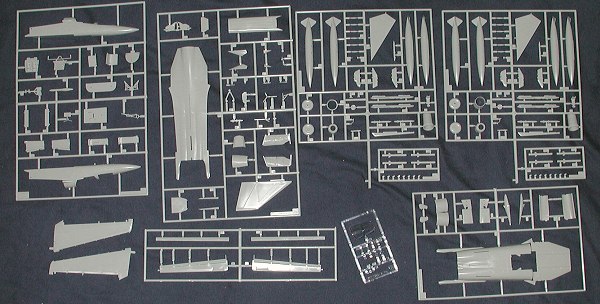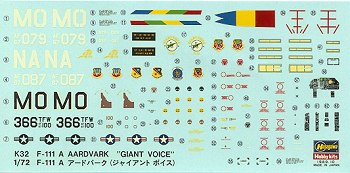
|
KIT: |
Hasegawa 1/72 F-111A Aardvark |
|
KIT # |
4032 (K 32) |
|
PRICE: |
$30.00 MSRP |
|
DECALS: |
Three aircraft |
|
REVIEWER: |
|
|
NOTES: |
Currently out of production. 1989 boxing |

|
HISTORY |
Originally known as the TFX (Tactical Fighter "X"), the F-111 was conceived to meet a USAF requirement for a new tactical fighter-bomber. In 1960, the Department of Defense combined the USAF's requirement with a Navy need for a new air superiority fighter, then launched a competition among aircraft manufacturers for the final design. In 1962, General Dynamics and Boeing were selected as finalists with the General Dynamics TFX design eventually winning out. The Navy version was known as the F-111B and the USAF version the F-111A. The first flight of the F-111A took place in December 1964, and the first production models were delivered to the USAF in 1967. Meanwhile, the Navy's F-111B program was canceled as it didn't meet the needs of the Navy being too large and too complex a system for carrier operations. This only goes to show that a 'one plane does all' deal isn't always the best. Interestingly, during all of this there was an aircraft that met and in many cases exceeded the requirements of the USN, USAF and USMC; the F-4 Phantom II.
In all, 562 F-111s of all series were built; 159 of them were preproduction and production F-111As. Many of the F-111As were rebuilt as EF-111As and those were the final type retired in 1996, the A models having been sent to the boneyard at least a decade earlier. F-111s still ply the skies of Australia where their special-built F-111Cs have been joined by ex SAC FB-111As that were converted to F-111Gs and operated in tactical squadrons for a couple of years before being retired.
|
THE KIT |

It goes without saying that this is probably the ultimate 1/72 F-111A kit. Hasegawa produced the entire series of F-111s and some additional special boxings (actually just decal switches). These seem to have pretty well disappeared from store shelves and catalogues. The latest Squadron Catalogue (2003) has none of the nearly dozen boxings listed.
As you can expect, it is superbly molded with no flash or sink areas that I could spot right away. There are some ejector pin marks on some of the smaller pieces that will have to be dealt with. Typical of Hase 1/72 kits, the cockpit instrument panels and side consoles are decals. The canopy cannot be displayed in the open positions, but the plastic is very clear so the interior can easily be seen. The rather complex intake shapes are well done as is the equally complicated main gear bay.
The wings can only be displayed in the forward position as the slats and flaps will prevent them from being swept back. The fuselage opening is also not large enough to permit this. There are no missiles or bombs included but there are large drop tanks and some other missile that I believe is a Durandel included along with a MER so you can fill the pylons. A gun pod is also provided for the centerline.
I nstructions are superb and
provide Gunze paint references as well as general and FS color references.
Markings are provided for three aircraft. All are in the modified SEA camo
scheme with the black underside instead of the normal light grey. First is
the box art plane from the 366 TFW at Mountain Home AFB circa 1978. A later
366 TFW bird from when then switched to black tail codes and
lettering is also provided. The other is from the 429 FS/474 TFW at Nellis
AFB, the first unit to fly the F-111A. There are several aftermarket decal
sheets for other F-111A aircraft available if you search them out. The
Hasegawa kit decals are well printed, a bit thick and have ivory vice white
for some decals. They also are hit and miss when it comes to setting
solutions so be advised and forewarned!
nstructions are superb and
provide Gunze paint references as well as general and FS color references.
Markings are provided for three aircraft. All are in the modified SEA camo
scheme with the black underside instead of the normal light grey. First is
the box art plane from the 366 TFW at Mountain Home AFB circa 1978. A later
366 TFW bird from when then switched to black tail codes and
lettering is also provided. The other is from the 429 FS/474 TFW at Nellis
AFB, the first unit to fly the F-111A. There are several aftermarket decal
sheets for other F-111A aircraft available if you search them out. The
Hasegawa kit decals are well printed, a bit thick and have ivory vice white
for some decals. They also are hit and miss when it comes to setting
solutions so be advised and forewarned!
|
CONCLUSIONS |
You want the best F-111 kit available in 1/72 (and probably any scale) then this is the one to get. It will be a fiddly construct as are most modern Hasegawa multi-mode kits, but the end results will be most pleasing.
Review kit courtesy of me.
If you would like your product reviewed fairly and fairly quickly by a site that has over 200,000 visitors a month, please contact me or see other details in the Note to Contributors.